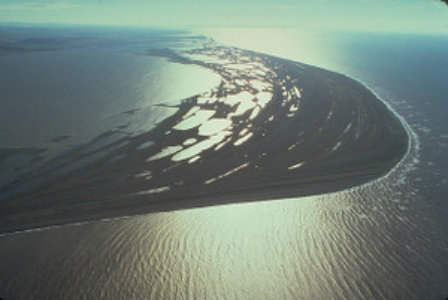
Courtesy of Western Arctic National Parklands through Flickr’s Creative Commons
In the 1950s and 1960s, archeologists J. Louis Giddings and Douglas D. Anderson, and local Inupiaq resident Almond Downey discovered archeological sites on a sequence of beach ridges along the Chukchi Sea shoreline of Northwest Alaska. Since then, archeologists have continued researching and interpreting the evidence preserved within the ancient beach ridges of Cape Krusenstern, the most extensive in Northwest Alaska. The beach ridges began forming at Krusenstern approximately 5,000 years ago when the sea level stabilized. For the last 60 years, archeologists have collected and studied tens of thousands of artifacts, historic items, and biological specimens that have provided great insight into understanding the cultures of Northwest Alaska. Today, Cape Krusenstern National Monument protects the series of more than 100 beach ridges that have preserved over 5,000 years of the history and culture of the Inupiat Eskimos and those who went before them. Humans of many cultural traditions with different patterns of subsistence, settlement, and socio-economic organization have occupied the region.
While the beach ridges of the National Monument are the focus of a multi-year research project, the modern Inupiat continue to live in Cape Krusenstern, where they practice a subsistence lifestyle carried out for thousands of years. Like their ancestors, they depend greatly on Cape Krusenstern’s rich natural resources to survive the region’s harsh arctic environment. As an untamed wilderness, Cape Krusenstern is home to a wide range of terrestrial and marine animals, which for centuries have helped sustain the native communities of the arctic north. In the dryer regions of the 70-mile coastal plain, residents make use of the abundance of blueberries, cranberries, salmonberries, and Labrador tea. In the summer, wildflowers color the landscape where caribou, moose, hares, foxes, wolves, and muskoxen roam free. Cape Krusenstern is also dotted with a number of large lagoons, where migratory birds feed in the fall.
Along the outer beaches, using traditional tools and ancient practices, the Inupiat continue to hunt seals and bowhead whales. Although Native Alaskans benefit from Cape Krusenstern’s wide range of mammals and extensive vegetation, whaling is the most important element in the Inupiat culture and history. Whaling not only provides the Inupiat people with food, but also creates a strong sense of community. For thousands of years, whaling has bonded Inupiat families closely together, since hunting for whales is an activity that requires the involvement of every member of the community. While the elders and the young Inupiat boys hunt, the women dry the whale skin and store the meat in ice cellars. The Inupiat women also keep track of the food inventory and are responsible for sewing sealskins together to cover theumiaq or whaling boat.
By whaling, the Inupiat have developed strong relationships among neighboring communities, as they continue to share and distribute food among Inupiat families who help carve the whales. Historically, the wife of the umialik--the male head of the family--was responsible for managing the redistribution of the whale meat. The captains’ wives follow this tradition today, preparing feasts the modern Inupiat share with neighboring communities, participating with them in the nalukataq or blanket toss to celebrate and give thanks to the sea for a successful whaling season.
Whaling also plays a significant role in the spiritual life of the Inupiat, who strive to live in harmony with the land and sea and show great respect for the food and other natural resources available in the arctic north. Toward the end of the whaling season, the present-day Inupiat continue to follow their ancestral tradition of returning the whale’s carcass back into the ocean. The act, they hope, will please the spirits of the sea, since the Inupiat believe that the spirit of the whale they hunted will inform living whales and other marine mammals of the great treatment it received and of the overall respect and gratitude of Inupiat families for Alaska’s natural resources.
At Cape Krusenstern National Monument, visitors can participate in a range of outdoor activities such as hiking, kayaking, camping, and backpacking. During the winter, they can traverse the park on snow machines, skis, and dog sleds. Visitors are welcome to photograph the wildlife and magnificent scenery, as well as the cultural artifacts. Clickto learn more about the laws protecting Cape Krusenstern’s archeological sites on public land.
Researchers are performing fieldwork throughout the park. Since 2009, surveys of over 9,000 acres of the beach ridges have recovered pottery and fragments of tools from a native settlement dating to 1,000 years ago. Archeologists from the National Park Service and the University of Washington also discovered two wood lined storage features and other debris. Researchers continue to survey and investigate the land hoping to gain a greater understanding of the interactions between past cultures and the environment of Cape Krusenstern. To learn more about the archeological findings, visit the Cape Krusenstern National Monument Museum Collections website.
A word of caution--because Cape Krusenstern is an untamed wilderness with no roads or trails, only visitors skilled in outdoor exploration and how to survive rough winds, rain, and snow are encouraged to visit. There are no visitor centers or facilities at Cape Krusenstern. The park headquarters and visitor center are located an airplane ride away. The Northwest Arctic Heritage Center in Kotzebue, Alaska offers a variety of educational programs, ranging from Junior Ranger programs, to research presentations, to native crafts and dancing, and a wide range of interpretive experiences that provide insights into the cultural history of Northwest Alaska.Last updated: June 10, 2024
